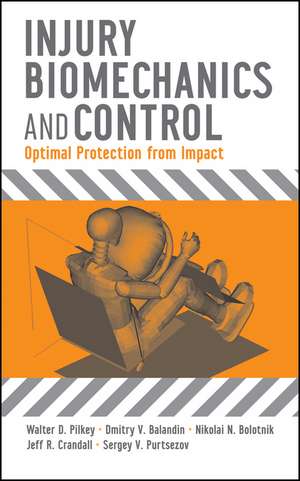Injury Biomechanics and Control – Optimal Protection from Impact
Autor WD Pilkeyen Limba Engleză Hardback – 7 dec 2009
Using examples from automotive, aviation, and military areas, the authors demonstrate how optimal shock isolation theory enables designers to improve the performance of protective equipment by incorporating control and optimization methods developed for shock isolation systems.
The first part of Injury Biomechanics and Control lays down the engineering foundation, setting forth core principles and techniques, including:
-
Fundamentals of impact and shock isolation systems
-
Basic optimal shock isolation for single-degree-of-freedom systems
-
Optimal shock isolation for multi-degree-of-freedom systems
The second part applies the principles set forth in the first part to solve real-world problems, using simple mathematical models that simulate the mechanical response of human bodies to impact loads in order to optimize shock isolation systems. This book enables scientists, engineers, and students in mechanical, biomechanical, and biomedical engineering to fully realize the potential of shock isolation methods for the development of protective equipment and devices.
Preț: 663.74 lei
Preț vechi: 974.15 lei
-32% Nou
127.01€ • 138.39$ • 107.02£
Carte indisponibilă temporar
Specificații
ISBN-10: 047010015X
Pagini: 304
Dimensiuni: 162 x 236 x 24 mm
Greutate: 0.64 kg
Editura: Wiley
Locul publicării:Hoboken, United States
Public țintă
Engineers and designers working in automotive, aerospace, and defense industries; students and researchers in mechanical and aerospace engineeringNotă biografică
Dmitry V. Balandin, Dsc (Physics And Mathematics), is the Chair of Numerical and Functional Analysis at Nizhny Novgorod State University, Nizhny Novgorod, Russia. His areas of expertise include shock isolation, automatic control, and theoretical mechanics. He received his MS, PhD, and DSc, from Nizhny Novgorod State University, Institute for Problems in Mechanics of the USSR Academy of Sciences, and Moscow State University, respectively.
Nikolai N. Bolotnik, Dsc (Physics And Mathematics), is the head of the Laboratory of Robotics and Mechatronics at the Institute for Problems in Mechanics of the Russian Academy of Sciences, Moscow, Russia. His areas of expertise include optimal control, shock isolation, and robotics. He received his MS, PhD, and DSc degrees from Moscow Institute of Physics and Technology, Institute for Problems in Mechanics of the USSR Academy of Sciences, and Moscow State University, respectively.
Jeff R. Crandall, PhD, received his BA degree from Dartmouth College and his PhD from the University of Virginia, where he is currently a professor in the Department of Mechanical and Aerospace Engineering and Director of the Center for Applied Biomechanics. His research involves characterizing human response and injury during dynamic loading.
Sergey V. Purtsezov, PhD, received his MS and PhD degrees from the Nizhny Novgorod State University, Russia, and is presently a research scientist at the Center for Applied Biomechanics of the University of Virginia. His research interests include shock isolation, measurement, and modeling in biomechanics.
